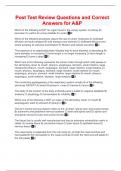Post Test Review Questions and Correct Answers for A&P Which of the following is NOT an organ found in the urinary system: A) kidney B) pancreas C) urethra D) urinary bladder E) ureter ✅B Which of the following processes require the use of carrier molecules A) facilitated diffusion and bulk transport B) bulk transport and osmosis C) facilitated diffusion and solute pumping D) osmosis and filtration E) filtration and cellular secretion ✅C The presence of an epiphyseal plate indicates that A) bone diameter is decreasing B) bone diameter is increasing C) bone length is no longer increasing D) bone length is increasing E) bone is dead ✅D Which one of the following represents the correct order through which food passes in the alimentary canal: A) mouth, pharynx, esophagus, stomach, small intestine, large intestine B) pharynx, mouth, esophagus, stomach, large intestine, small intestine C) mouth, pharynx, esophagus, stomach, large intestine, small intestine D) mouth, esophagus, pharynx, stomach, small intestine, large intestine E) mouth, pharynx, esophagus, small intestine, stomach, large intestine ✅A The conducting passageways of the respiratory system include all of the following structures EXCEPT A) alveoli B) pharynx ) nose D) trachea E) larynx ✅A The study of the function of the body and body parts is called A) negative feedback B) anatomy C) physiology D) homeostasis E) irritability ✅C Which one of the following is NOT an organ of the alimentary canal: A) mouth B) esophagusC) teeth D) stomach E) pharynx ✅C The term central nervous System refers to the: A) brain, spinal cord, and cranial nerves B) autonomic and peripheral nervous systems C) brain and spinal cord D) spinal cord and spinal nerves E) brain and cranial nerves ✅C The tissue that is usually well vascularized and has an extensive extracellular matrix in called: A) muscle tissue B) connective tissue C) brain tissue D) epithelial tissue E) nervous tissue ✅B The nasal cavity is separated from the oral cavity by: A) both the nasal conchae and hard palate B) the hard palate C) the nasal conchae D) both the hard and soft palate E) the soft palate ✅D Sweat glands associated with hair are: A) sudoriferous glands and eccrine glands B) sudoriferous glands C) sebaceous glands and eccrine glands D) eccrine glands E) sebaceous glands ✅B The canal that runs through the core of each osteon contains: A) red marrow B) osteoclasts and osteoblasts C) cartilage and lamellae D) blood vessels and nerve fibers E) yellow marrow and Sharpey's fibers ✅D The bone cells within lacunae receive nourishment from blood vessels through passageways called: A) lamellae B) perforating canals C) Haversian canals D) canaliculi E) medullary cavities ✅D DNA replication takes place during: A) interphase B) metaphase C) prophase D) telophase E) anaphase ✅A The fold of mucous membrane movementsthat secures the tonuge to the floor of the mouth and limits its posterior movements is called the: A) lingual frenulum B) mandibular frenulum C) palatal frenulum D) hyoid bone E) styloid bone ✅A Identify the type of tissue that is found in lymph nodes, the spleen, and bone marrow A) areolar tissue B) reticular connective tissue C) adipose tissue D) dense connective tissue E) osseous tissue ✅E The three major components of the cytoplasm are the: A) organelles, inclusions, and nucleoli B) cytosol, inclusions, and nucleoli C) organelles, inclusions, and ribosomes D) cytosol, organelles, and inclusions E) cytosol, organelles, and nucleoli ✅D The categories of epithelial tissue membranes are: E) synovial, cutaneous, and serous membranes D) mucous, cutaneous, and serous membranes C) synovial, mucous, and serous membranes B) synovial, cutaneous, and mucous membranes A) synovial, mucous, and cutan eous membranes ✅D The gas exchange that occurs between blood and tissue cells at systemic capillaries is called: A) respiratory gas transport ) pulmonary ventilation C) expiration D) internal respiratior E) external respiration ✅D The type of muscle found in the walls of hollow organs, such as the stomach, and in the walls of blood vessels is: A) both cardiac muscle and skeletal muscle B) both smooth muscle and skeletal muscle C) smooth muscle D) cardiac muscle E) skeletal muscle ✅C Which one of the vitamin D from its inactive to its active form following is NOT one of the functions of the kidneys A) convert vitamin D from its inactive form B) regulate blood volume C) dispose of metabolic waste products D) manufacture urine E) produce hormones that assist in digestion ✅E




